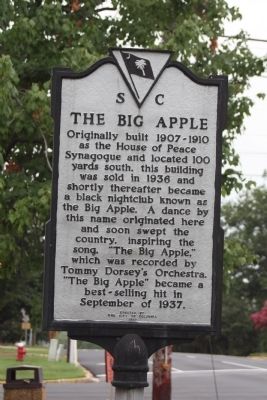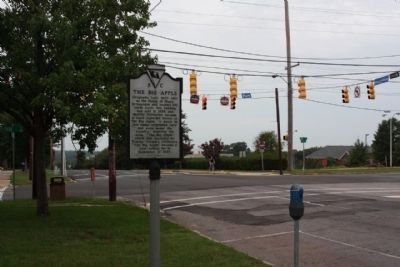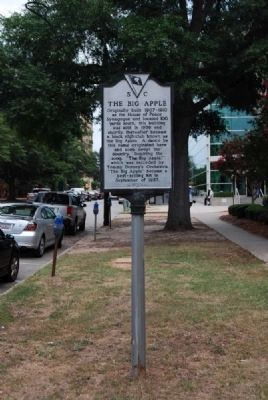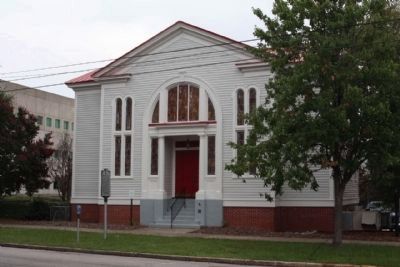Midtown - Downtown in Columbia in Richland County, South Carolina — The American South (South Atlantic)
The Big Apple
Originally built 1907-1910 as the House of Peace Synagogue and located 100 yards south, this building was sold in 1936 and shortly thereafter became a black nightclub known as the Big Apple. A dance by this name originated here and soon swept the country, inspiring the song, "The Big Apple," which was recorded by Tommy Dorsey's Orchestra. "The Big Apple" became a best-selling hit in September of 1937.
Erected 1987 by City of Columbia. (Marker Number 40-101.)
Topics. This historical marker is listed in these topic lists: African Americans • Arts, Letters, Music • Churches & Religion • Entertainment. A significant historical month for this entry is September 1937.
Location. 34° 0.252′ N, 81° 2.295′ W. Marker is in Columbia, South Carolina, in Richland County. It is in Midtown - Downtown. Marker is at the intersection of Hampton Street and Park Street, on the right when traveling east on Hampton Street. Touch for map. Marker is at or near this postal address: 1000 Hampton Street, Columbia SC 29201, United States of America. Touch for directions.
Other nearby markers. At least 8 other markers are within walking distance of this marker. Nathaniel J. Frederick House (about 300 feet away, measured in a direct line); St. Peter's Church and Ursuline Convent (about 400 feet away); North Carolina Mutual Building (about 500 feet away); St. Peter's Roman Catholic Church (about 500 feet away); Israelite Sunday School / Columbia's First Synagogue (about 500 feet away); Victory Savings Bank (about 600 feet away); Early Howard School Site (about 700 feet away); 'We Kept the Fire Going' (approx. 0.2 miles away). Touch for a list and map of all markers in Columbia.
Regarding The Big Apple. Tommy Dorsey had seventeen number one hits with his orchestra in the 1930s and 1940s: “On Treasure Island”, “The Music Goes ‘Round and Around”, “Alone”, “You”, “Marie”, “Satan Takes a Holiday”, “The Big Apple”, “Once in a While”, “The Dipsy Doodle”, “Music, Maestro, Please”, “Our Love”, “All the Things You Are”, “Indian Summer”, “I’ll Never Smile Again”, “There Are Such Things”, “In the Blue of Evening”, and “Dolores”.
Also see . . .
1. House of Peace Synagogue (The Big Apple Club). The structure
located at 1318 Park Street was constructed between 1907 and 1910 as a Jewish Synagogue. (Submitted on September 13, 2011, by Brian Scott of Anderson, South Carolina.)
2. House of Peace Synagogue. The House of Peace Synagogue is a former synagogue of the Beth Shalom Congregation in Columbia, South Carolina. (Submitted on September 13, 2011, by Brian Scott of Anderson, South Carolina.)
3. Tommy Dorsey. Thomas Francis "Tommy" Dorsey, Jr. (November 19, 1905 – November 26, 1956) was an American jazz trombonist, trumpeter, composer, and bandleader of the Big Band era. (Submitted on September 13, 2011, by Brian Scott of Anderson, South Carolina.)
4. Big Apple Dance. The Big Apple is both a partner dance and a circle dance that originated in the Afro-American community of the United States in the beginning of the 20th century. (Submitted on September 13, 2011, by Brian Scott of Anderson, South Carolina.)
Additional commentary.
1. House of Peace Synagogue (The Big Apple Club) - National Register Nomination Form (1979)
Description
The structure located at 1318 Park Street, several blocks from Columbia's Main Street, is a two-story wooden edifice set upon a raised brick basement. Its gable roof is covered by tin, and its facades are covered by wood siding. Constructed between 1907 and 1910 as a Jewish Synagogue, the structure features a projecting central bay. The entrance, located in this bay and flanked by wooden pilasters and sidelights, is surmounted by a large arch. This arch is divided into four sections, the central two being 6/6 windows. On each side of the entrance are tall narrow windows with horseshoe arches. This entire central projection is capped by a pedimented gable.
The side facades also feature pedimented gables with a rondelle. Each side has five windows with horseshoe arches but several of these windows have been altered. A one-story cement block addition is attached to the rear of the structure.
Significance
The structure located at 1318 Park Street was constructed between 1907 and 1910 as a Jewish Synagogue. Its interior architecture, including a notable recessed dome and a balcony, reflect its original function. However, the structure gained its greatest notoriety when used in the 1930s as a black night club. During that time, students from the nearby University of South Carolina came to observe dancers at "The Big Apple Club." The dance, known as the Big Apple, became extremely popular and in 1937 a group of twenty-three from the Big Apple Club appeared in New York before touring the United States.
Since its use as a dance club, the structure has been used by a variety of commercial enterprises. It is now the home of Lynn's Heating and Air Conditioning.
— Submitted September 13, 2011, by Brian Scott of Anderson, South Carolina.
Credits. This page was last revised on February 16, 2023. It was originally submitted on August 24, 2009, by Mike Stroud of Bluffton, South Carolina. This page has been viewed 1,247 times since then and 60 times this year. Last updated on April 14, 2021, by Carl Gordon Moore Jr. of North East, Maryland. Photos: 1, 2. submitted on August 24, 2009, by Mike Stroud of Bluffton, South Carolina. 3. submitted on September 13, 2011, by Brian Scott of Anderson, South Carolina. 4. submitted on August 24, 2009, by Mike Stroud of Bluffton, South Carolina. • Bernard Fisher was the editor who published this page.



